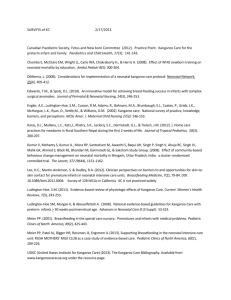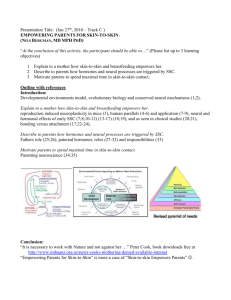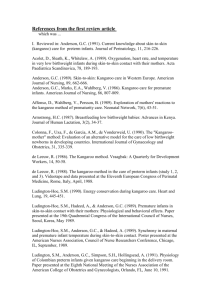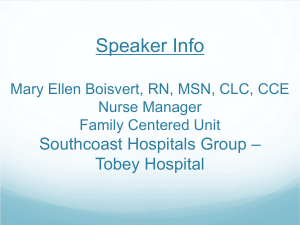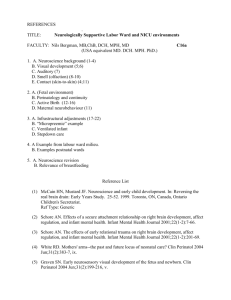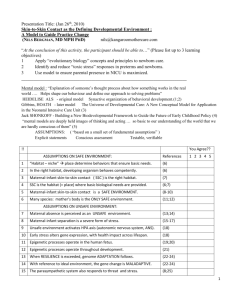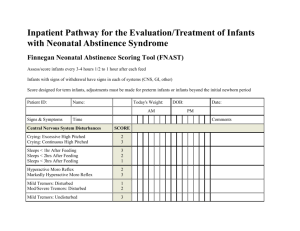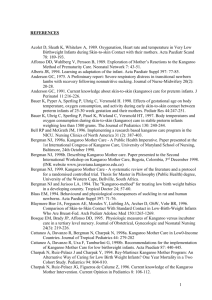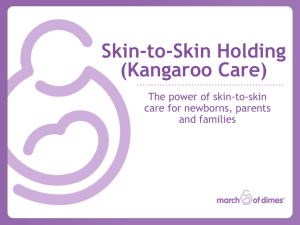Reference list - Skin to Skin Contact
advertisement
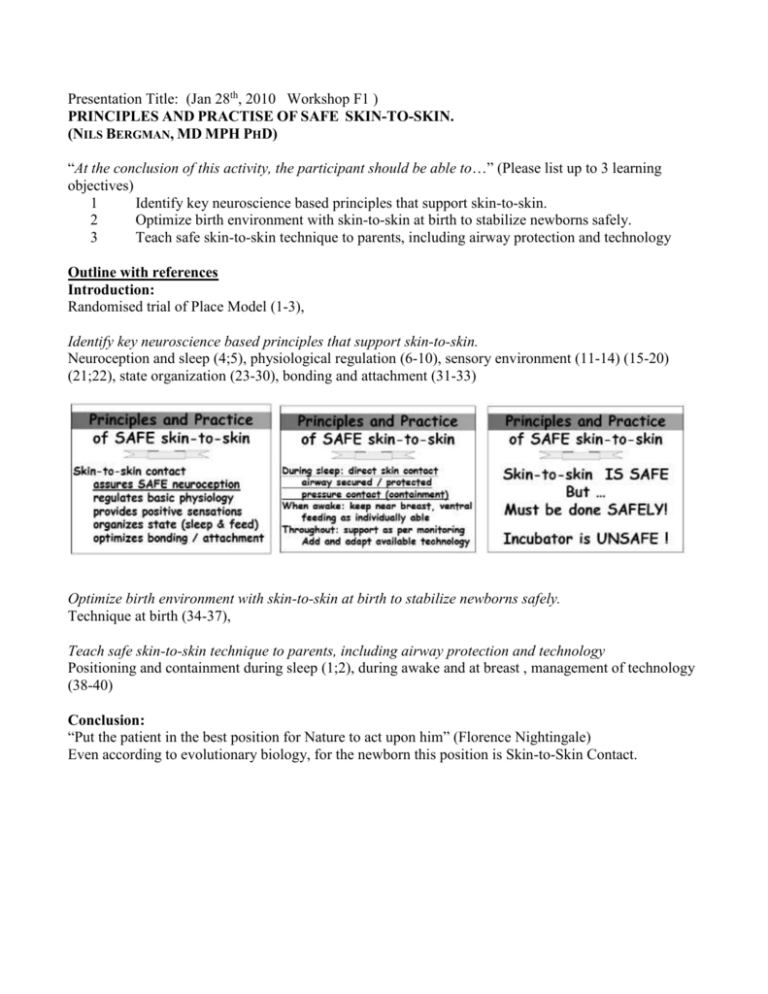
Presentation Title: (Jan 28th, 2010 Workshop F1 ) PRINCIPLES AND PRACTISE OF SAFE SKIN-TO-SKIN. (NILS BERGMAN, MD MPH PHD) “At the conclusion of this activity, the participant should be able to…” (Please list up to 3 learning objectives) 1 Identify key neuroscience based principles that support skin-to-skin. 2 Optimize birth environment with skin-to-skin at birth to stabilize newborns safely. 3 Teach safe skin-to-skin technique to parents, including airway protection and technology Outline with references Introduction: Randomised trial of Place Model (1-3), Identify key neuroscience based principles that support skin-to-skin. Neuroception and sleep (4;5), physiological regulation (6-10), sensory environment (11-14) (15-20) (21;22), state organization (23-30), bonding and attachment (31-33) Optimize birth environment with skin-to-skin at birth to stabilize newborns safely. Technique at birth (34-37), Teach safe skin-to-skin technique to parents, including airway protection and technology Positioning and containment during sleep (1;2), during awake and at breast , management of technology (38-40) Conclusion: “Put the patient in the best position for Nature to act upon him” (Florence Nightingale) Even according to evolutionary biology, for the newborn this position is Skin-to-Skin Contact. Reference List (1) Bergman NJ, Jurisoo LA. The 'kangaroo-method' for treating low birth weight babies in a developing country. Trop Doct 1994 April;24(2):57-60. (2) Bergman NJ, Linley LL, Fawcus SR. Randomized controlled trial of skin-to-skin contact from birth versus conventional incubator for physiological stabilization in 1200- to 2199-gram newborns. Acta Paediatr 2004 June;93(6):779-85. (3) Fischer CB, Sontheimer D, Scheffer F, Bauer J, Linderkamp O. Cardiorespiratory stability of premature boys and girls during kangaroo care. Early Human Development 1998;52(2):145-53. (4) Porges SW, Doussard-Roosevelt JA, Stifter CA, McClenny BD, Riniolo TC. Sleep state and vagal regulation of heart period patterns in the human newborn: an extension of the polyvagal theory. Psychophysiology 1999 January;36(1):14-21. (5) Porges SW. The polyvagal perspective. Biological Psychology 2007 February;74(2):116-43. (6) Anderson GC. Current knowledge about skin-to-skin (kangaroo) care for preterm infants. J Perinatol 1991 September;11(3):216-26. (7) Christensson K, Siles C, Moreno L, Belaustequi A, de la FP, Lagercrantz H et al. Temperature, metabolic adaptation and crying in healthy full-term newborns cared for skin-to-skin or in a cot. Acta Paediatrica (Oslo, Norway: 1992) 1992 June;81(6-7):488-93. (8) Ludington-Hoe SM, Swinth JY. Developmental aspects of kangaroo care. J Obstet Gynecol Neonatal Nurs 1996 October;25(8):691-703. (9) Moore ER, Anderson GC, Bergman N. Early skin-to-skin contact for mothers and their healthy newborn infants. Cochrane Database of Systematic Reviews 2007 September;(3):1469-93. (10) Syfrett EB, Anderson GC. Early and virtually continuous kangaroo care for lower-risk preterm infants: effect on temperature, breastfeeding, supplementation and weight. American Nurses Association, Paper presented at the biennial conference of the Council of Nurse Researchers, November 1993. 1993. Ref Type: Abstract (11) Mirmiran M, Kok jh. Circadian rhythyms in early human development. Early Hum Dev 1991;26:121-8. (12) Rea M. Lighting for caregivers in the neonatal intensive care unit. Clin Perinatol 2004 June;31(2):229-42, vi. (13) Rivkees SA. Emergence and influences of circadian rhythmicity in infants. Clin Perinatol 2004 June;31(2):217-vi. (14) White RD. Lighting design in the neonatal intensive care unit: practical applications of scientific principles. Clin Perinatol 2004 June;31(2):323-30, viii. (15) Fifer.W.P, Moon CM. The role of mother's voice in the organization of brain function in the newborn. Acta Paediatr 1994;Suppl 397:86-93. (16) Philbin MK. Planning the acoustic environment of a neonatal intensive care unit. Clin Perinatol 2004 June;31(2):331-52, viii. (17) Philbin MK, Robertson A, Hall JW, III. Recommended permissible noise criteria for occupied, newly constructed or renovated hospital nurseries... Reprinted with permission from Macmillan Publishers Ltd: Journal of Perinatology. Philbin MK, Robertson A, Hall III JW. Recommended permissible noise criteria for occupied, newly constructed or renovated hospital nurseries. 19(8) Part 1, 559-63. Advances in Neonatal Care (Elsevier Science) 2008 October 2;8(5S):S11-S15. (18) Gray L, Philbin MK. Effects of the neonatal intensive care unit on auditory attention and distraction. Clin Perinatol 2004 June;31(2):243-60. (19) Long JG, Lucey JF, Philip AG. Noise and hypoxemia in the intensive care nursery. Pediatrics 1980 January;65(1):143-5. (20) Zahr LK, Balian S. Responses of premature infants to routine nursing interventions and noise in the NICU. Nursing Research 1995 May;44(3):179-85. (21) Doucet S, Soussignan R, Sagot P, Schaal B. The secretion of areolar (Montgomery's) glands from lactating women elicits selective, unconditional responses in neonates. PLoS One 2009 October 23;4(10):e7579. (22) Schaal B, Hummel T, Soussignan R. Olfaction in the fetal and premature infant: functional status and clinical implications. Clin Perinatol 2004 June;31(2):261-vii. (23) Curzi-Dascalova L, Figueroa JM, Eiselt M, Christova E, Virassamy A, D'Allest AM. Sleep state organization in premature infants of less than 35 weeks gestational age. Pediatr Res 1993;34:624-8. (24) Feldman R, Eidelman AI. Skin-to-skin contact (Kangaroo Care) accelerates autonomic and neurobehavioural maturation in preterm infants. Dev Med Child Neurol 2003 April;45(4):27481. (25) Karl DJ. Using principles of newborn behavioral state organization to facilitate breastfeeding. MCN: The American Journal of Maternal Child Nursing 2004 September;29(5):292-8. (26) Ohgi S, Fukuda M, Moriuchi H, Kusumoto T, Akiyama T, Nugent JK et al. Comparison of Kangaroo Care and Standard Care: Behavioral Organization, Development, and Temperament in Healthy, Low-Birth-Weight Infants Through 1 Year. Journal of Perinatology 2002 July;22(5):374-9. (27) Ludington-Hoe Sm. Preterm skin contact effects on electrophysiologic sleep. Research ShowCASE [4 April], 192. 2003. Ref Type: Abstract (28) Ludington-Hoe Sm, Johnson MW, Morgan K, Lewis T, Gutman J, Wilson D et al. Neurophysiologic assessment of neonatal sleep organization: Preliminary results of a randomized, controlled trial of skin contant with preterm infants. Pediatrics 2006 May;112(5):e909-e923. (29) Peirano P, Algarin C, Uauy R. Sleep-wake states and their regulatory mechanisms throughout early human development. Journal of Pediatrics 2003 October 2;143(4):S70-S79. (30) Panksepp J. Affective neuroscience. Oxford Univarsity Press; 1998. (31) Browne JV. Early relationship environments: physiology of skin-to-skin contact for parents and their preterm infants. Clin Perinatol 2004 June;31(2):287-98, vii. (32) White RD. The sensory environment of the NICU: scientific and designed-related aspects. Clin Perinatol 2004 June;31(2). (33) White RD. Mothers' arms--the past and future locus of neonatal care? Clin Perinatol 2004 June;31(2):383-7, ix. (34) Righard L, Alade MO. Effect of delivery room routines on success of first breast-feed. Lancet 1990 November 3;336(8723):1105-7. (35) Smith J, Plaat F, Fiska NM. The natural caesarean: a woman-centred technique. BJOG 2008;115:1037-42. (36) Westrup B. Family-centered developmentally supportive care in neonatal intensive care units. Encyclopedia of Early Childhood Develolment 2004;1-5. (37) Widstrom A-M, Lilja G, Aaltomaa-Michalias P, Dahllof A, Lintula M, Nissen E. Newborn behaviour to locate the breast when skin-to-skin: a possible method for enabling early self-regulation. Acta Paediatrica 2010;1-7. (38) Ludington-Hoe Sm, FC, SJ, .Ceccardi JJ. Safe Criteria and Procedure for Kangaroo Care with Intubated Preterm Infants. JOGNN: Journal of Obstetric, Gynecologic, & Neonatal Nursing 2003 September;32(5):579-88. (39) Ludington-Hoe Sm, Morgan K, Abouelfettah A. A clinical guideline for implemetation of kangaroo care with premature infants of 30 or more weeks' postmenstrual age. Advances in Neonatal Care 2008;8(3 S):S3-S23. (40) WHO. Kangaroo mother care - a practical guide. WHO; 2003.
